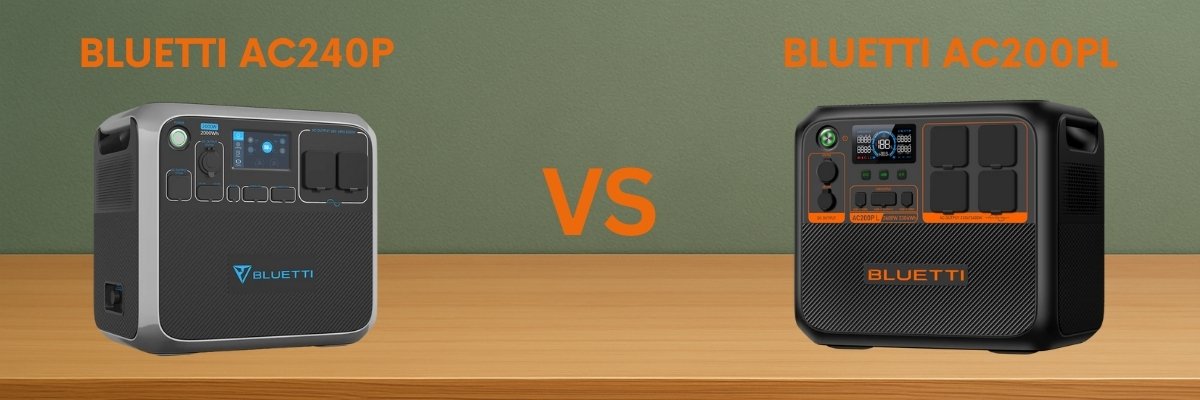
Bluetti AC200P vs AC200PL: Choosing Your Ideal Australian Power Station
Looking at the Bluetti AC200P vs AC200PL and not sure which one to choose? Both are powerful, off-grid-ready portable generators — but one charges faster, delivers more output, and includes smart features. Let’s break it down so you know exactly which model fits your setup.
Not sure which power station is right for you?
Take the quiz!
Core Performance Differences in These Portable Generators
Power Output and Battery Capacity: AC200P vs AC200PL Specs
AC Output: Continuous vs. Surge Power for Your Generator
- AC200P: 2,000W continuous | 4,800W surge | 2 × 240V
- AC200PL: 2,400W continuous | 3,600W surge | 4 × 230V
The AC200PL delivers more continuous power and double the AC ports, while the AC200P handles slightly higher surge spikes.
Battery Type, Capacity, and Cycle Life of the Portable Generator
- Both use LiFePO₄ (Lithium Iron Phosphate) for safe, long-term power
- AC200P: 2,000Wh | 3,500+ cycles to 80%
- AC200PL: 2,304Wh | 3,000+ cycles to 80%
The AC200PL gives you more usable capacity, while the AC200P has slightly better long-term cycle life.
Expandability Options for Your Power Generator (if applicable)
- AC200P: No battery expansion supported
- AC200PL: Compatible with B210, B230, and B300K batteries
Only the AC200PL allows modular expansion, making it more future-proof for growing needs.
Charging Speeds and Input Flexibility: AC200P vs AC200PL Specs
AC Charging: Wall Outlet Speeds for Your Generator
- AC200P: 500W input – approx. 4.5–5 hrs
- AC200PL: Up to 2,400W turbo AC input – approx. 1.5 hrs
The AC200PL charges significantly faster, making it ideal for short prep windows or frequent use.
Solar Charging Efficiency and Max Input for the Generator
- AC200P: 700W max solar input
- AC200PL: 1,200W max solar input
The AC200PL is better suited for high-output solar setups, recharging quicker even off-grid.
Dual Charging Capabilities for Faster Generator Recharging
- AC200P: Combined input (AC + Solar) = 1,200W
- AC200PL: Combined input = 2,400W
The AC200PL supports higher dual input capacity, cutting recharge time dramatically when both AC and solar are available.

Enhancing Your Experience and Design of Each Power Generator
Key Features, Design, and Portability: AC200P vs AC200PL Specs
App Control, Wireless Charging, and Other Convenient Features of the Generator
- AC200P: Wireless charging pads (2 × 15W), no app control
- AC200PL: Wireless charging pads (2 × 15W), full app control via Bluetooth/Wi-Fi
Only the AC200PL supports mobile app control, allowing remote monitoring and settings adjustment from your phone.
Weight, Dimensions, Noise Levels, and Operational Temperature Range of Each Generator
- AC200P: 27.5 kg | 42 × 28 × 38.65 cm | 0–40°C operating temp
- AC200PL: 28.8 kg | 42 × 28 × 36.65 cm | -20–40°C discharge temp
While slightly heavier, the AC200PL offers a broader operating range, especially useful in colder Australian climates.

Choosing the Right Portable Power Generator for Your Needs
Ideal Use Cases and Value Proposition of Each Generator
Best Generator for Camping and Outdoor Adventures
AC200P: A solid, budget-friendly option for occasional camping trips, thanks to wireless charging and excellent battery longevity.
AC200PL: Faster to recharge via solar and AC — better for longer trips or solar-based setups.
Top Generator for Home Backup and Emergency Preparedness
AC200P: Great for powering essentials, but slower to recharge between uses.
AC200PL: Faster charging and more output ports make it a better fit for powering fridges, routers, and lights during blackouts.
Optimal Generator for RV Use and Off-Grid Living
AC200P: Lacks expandability and remote app control, making it less ideal for full-time off-grid setups.
AC200PL: Expandable, app-controlled, and fast to recharge — the stronger RV/off-grid performer.

Price, Warranty, and Long-Term Value of Your Generator Investment
Understanding the Cost-Benefit of Each Portable Generator
The AC200P is more affordable and well-suited for basic needs, while the AC200PL delivers better value for money over time with higher input/output and smart control.
Warranty Coverage and After-Sales Support for Your Generator
- AC200P: 2-year warranty
- AC200PL: 5-year warranty
The AC200PL’s extended warranty is ideal for anyone relying on their unit for frequent or critical use.


